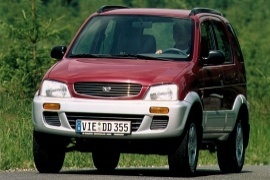
DAIHATSU Terios
Generations Timeline, Specs and Pictures

The second generation of the Daihatsu Terios first appeared at the 2005 Tokio Auto Show in the form of the D-Concept 4x4, while production for the road version started a year later.
It is almost 20 centimeters wider than the first kei car based generation, its new dimensions making it a compact SUV. On its Japanese home market the Terios is now sold as either the Daihatsu Be-go or as the Toyota Rush, while on the rest of the markets it kept its original name. Its engine choices are a 1.3 liter and a 1.5 liter, both of them being offered as either FWD or AWD, with a five speed manual or a four speed automatic.

Also sold under the Toyota Cami, Daihatsu Taruna and Perodua Kembara, the first generation of the Terios was a kei car sized SUV based on the Daihatsu Charade.
It even shared both of its engines with the little car: a 1.3 liter four cylinder and a 660 cc “kei car engine”. Available with both front wheel drive and al wheel drive, the Terios had options for the transmission: a five speed manual or a four speed automatic. In 2000 it received a mild facelift consisting of a new chrome grill, updated alloy wheels and a rear-mounted spoiler. The interior also benefited from standard electric front windows and central locking.

Daihatsu built the Terios as a new range for small off-road vehicles, and it suited better in the urban environment thanks to its small size.
Daihatsu was one of the oldest internal combustion engine manufacturers in Japan, and it was specialized in small off-road vehicles. Its presence on the European market was helped by its cooperation with Bertone design studio and BMW, who supplied the engines. On the other hand, Terios was a 100% Japanese vehicle built as a global contender for the small carmaker. It was available on most continents.
Its look was determined by the Kei-car Japanese category, which affected its size. A short hood at the front and very steep A-pillars started the form of the small crossover. While the Japanese version had to fit inside a 3.4m (133.7”) length, the rest of the world received the full-size version with a 3.8m (152”) long version. The car featured taillights mounted high on the D-pillars. Due to the short vehicle length, the carmaker had to install the spare wheel on the tailgate. That was a detail that enhanced the off-road look of the car.
Inside, it could barely fit four adults in a very tight cabin. The vehicle was so narrow that an average height adult could easily reach the doors from the right side, from the car’s left side. Its dashboard followed the Japanese minimalist design style. Its ventilation controls were placed on the center stack, over the radio-cassette player. In the instrument cluster, Daihatsu made room for two large dials and two gauges.
Under the hood, Daihatsu installed a small range of engines, depending on the market. The most common version was the 1.3-liter gasoline unit paired with a 5-speed manual. A 4-speed automatic was on the options list.























































